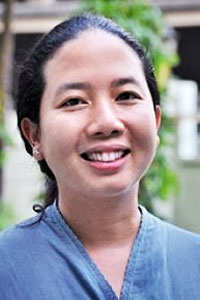
'I can't figure it out. Thai officials told us to leave and [we'll] probably have to end up living in the forest. We need to squeeze ourselves among the cracks of the ravines to keep ourselves safe from airstrikes by the Myanmar army," Naw Lay Bue, a Karen housewife with her three-month-old baby in her arms, told me in an interview in March, a few days after she and other villagers fled to Thailand following air raids launched by the Myanmar army in Karen State.
"We feel safer while in Thailand. But we were just told by the Thai officials that their commanders are coming for an inspection. We are concerned. How we can raise our families and young children [in Myanmar]? What can we do?"
For over a month, they lived in a makeshift shelter with a small piece of canvas as their roof. Some children fleeing the war have fallen ill, suffering from diarrhoea and malaria with barely any access to medical treatment.
In April, Naw Lay Bue and over 3,500 other villagers were told by Thai security forces to return to Myanmar. We've lost contact since. Yet, most of the Karen villagers could not return home as the fighting between the Karen National Liberation Army (KNLA) and the Myanmar military has remained intense.
Supplies of rice, medicine and other necessities donated by the Thai public are still kept by various charities, temples and churches in the border town of Mae Hong Son. Relief groups and international organisations, including the United Nations, have found it impossible to send relief items to Karen villagers who hide in villages in the area opposite the Thai border.
Accessing Myanmar is impossible as the Myanmar junta has banned the entry of aid since February. It is no longer possible to send relief items across the Salween River to Karen State too as Thai authorities have also restricted unauthorised access.
Although schools in Myanmar are now open, schools are under attack with air raids and shelling. Students have no idea when they can return to their classrooms again.
There have been reports that Karen teachers are dispatching mobile instructors to teach displaced children scattered across Karen State. They say people living along the border are trying their best to survive.
According to the latest report by the Karen Peace Support Network, the attacks by the terrorist Myanmar army in Karen State have led to the displacement of 70,000 people near the Thai-Myanmar border. These people had to flee after the strikes by Myanmar started in March.
Interestingly enough, a report says 700 stacks of rice had been mysteriously stacked near the Salween River since March 20. These supplies were supposed to be distributed to Myanmar army soldiers for several months. However, the sacks were believed to have been left there as the military was cordoned off by the KNLA, leaving Myanmar soldiers unable to retrieve the food supplies.
News of the supplies led to criticism and accusations that Thai security forces facilitated the transport of these supplies to the Myanmar military -- which the Thais sternly deny.
Following this news, the sacks of rice suddenly vanished, and now Thai security forces have been more serious in controlling the news and people's movements, including that of relief groups and international humanitarian organisations.
While Thai leaders have come out to guarantee access to humanitarian relief for people who are fleeing armed conflicts, in reality, the villagers who fled air strikes and rights violations by the Myanmar army have been pushed back several times.
Yet, the casualties of war are not limited to Myanmar civilians. Shells from the Myanmar military's air raids also fell in Chiang Mai province's Tha Ta Fang, in Mae Sariang district, causing Thai villagers to flee.
To date, a number of Thai citizens have not been able to return home to Tha Ta Fang village. Bunkers are being made for the first time in the school's village.
We have found that throughout the past three months, those fleeing from deadly violence have not been treated in accordance with humanitarian principles.
Today, many Karen villagers -- likely including Naw Lay Bue and the others -- are believed to be hiding in the forest. They can no longer seek safety in Thailand.
Why is there no safe area for these people who are our neighbours?
For these refugees, despite the commemoration of World Refugee Day tomorrow, there is no protection nor safety in sight.
The military coup in Myanmar on Feb 1 has led to chaos in various cities in Myanmar and along the border with Thailand. As tensions escalate, the Thai border is seen as the only safe haven for war refugees in the east.
In the past month, the eastern Kayah State saw as many as 100,000 displaced persons, with others in Myanmar fleeing violence and political risks.
As a neighbouring country, Thailand shares a 2,000-kilometre border with Myanmar. How can we avoid our obligation to offer humanitarian relief?
Pianporn Deetes is Regional Communication Director for Southeast Asia Programme at International Rivers, a global NGO working to defend the rights of rivers and communities.
